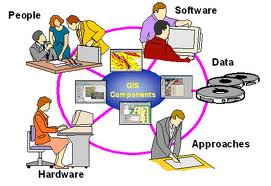Internal structure of the earth
The evidence of the transverse,longitudinal and surface waves set in motion during an earthquake has led to the conclusion that the globe or the earth consists of four layers one above the other if we proceed from the core of the earth outwards or one below the other if we proceed downwards from the crust of the earth.
The top most layer of the earth which forms the earth crust is the lightest layer.On this layer which is also known as lithosphere the main earthquake waves travel at a nominal speed of 3.5 miles per second while the speed of transverse waves is still less only 2 miles per second.The specific gravity of this layer is only 2.7 and its mean thickness is about 20 km.It is made of granite rocks,silica and aluminium predominate.Therefore,It is named in short SIAL.
Next this or below this top layer is the region of basalt rocks and this is heavier then the topmost layer.The specific gravity is 3.5.Through this layer the main waves have the speed of 4-4.5 miles per second while the transverse waves move at a speed of 2-2.5 miles per second.In this layer silica and magnesium elements dominate and it is known as SIMA.The upper region of this second layer is a short of mixture of SIAL and SIMA.SIMA layer forms the bottom of the ocean and is known as the pyrosphere.
Finally comes the central core of the earth.This is situated at a depth of 1800 miles.This central mass is made of nickel and iron,therefore,it is known as in short NIFE.Its specific gravity is 8.The core contains a third of the entire mass of the earth.It is made of very hard minerals and the materials of which it is made are very dense about ten times dense as the rest of the earth.But because of instance heat and pressure this core is not solid ,nor is it liquid.It is directly not gaseous.Its structure is elastic and viscous.Because its high specific gravity the main or longitudinal waves are unable to pierce it while its viscousness is elasticity prevents the transverse waves from passing through it.Evidence of elasticity and viscousness is provided by the rocks involved in mountain building and now exposed by denudation.These rocks seem to have flowed without melting,It is rigid but it is not hard.
Layers of the earth
There are mainly three layers of the earth - The crust
- The mantle
- The core
According to German scientist Gracht
- SIAL
- SIMA
- NIFE
According to Jeffrey
- Top layer
- Middle layer
- Lower layer
According to Prof. Holmes
- The crust
- The substrutum
- The core
- Lithosphere
- Pyrosphere
- Barysphere
The top most layer of the earth which forms the earth crust is the lightest layer.On this layer which is also known as lithosphere the main earthquake waves travel at a nominal speed of 3.5 miles per second while the speed of transverse waves is still less only 2 miles per second.The specific gravity of this layer is only 2.7 and its mean thickness is about 20 km.It is made of granite rocks,silica and aluminium predominate.Therefore,It is named in short SIAL.
Next this or below this top layer is the region of basalt rocks and this is heavier then the topmost layer.The specific gravity is 3.5.Through this layer the main waves have the speed of 4-4.5 miles per second while the transverse waves move at a speed of 2-2.5 miles per second.In this layer silica and magnesium elements dominate and it is known as SIMA.The upper region of this second layer is a short of mixture of SIAL and SIMA.SIMA layer forms the bottom of the ocean and is known as the pyrosphere.
Finally comes the central core of the earth.This is situated at a depth of 1800 miles.This central mass is made of nickel and iron,therefore,it is known as in short NIFE.Its specific gravity is 8.The core contains a third of the entire mass of the earth.It is made of very hard minerals and the materials of which it is made are very dense about ten times dense as the rest of the earth.But because of instance heat and pressure this core is not solid ,nor is it liquid.It is directly not gaseous.Its structure is elastic and viscous.Because its high specific gravity the main or longitudinal waves are unable to pierce it while its viscousness is elasticity prevents the transverse waves from passing through it.Evidence of elasticity and viscousness is provided by the rocks involved in mountain building and now exposed by denudation.These rocks seem to have flowed without melting,It is rigid but it is not hard.
Wednesday, January 12, 2011
The earth and its formation
The rains comes from the sky on the earth,the rivers flow over by their own minds,the highest mountain range,ocean,plateau,plain land,volcano,grassland etc. the beautiful nature have made the earth as a haven.
Book reference
- Essentials of ecology and environmental science-S.V.S. RANA
- PRAKRITIK BHIUGOL-Dr.Rejuan hossain bhhuian, Md. Khayrul Anam














